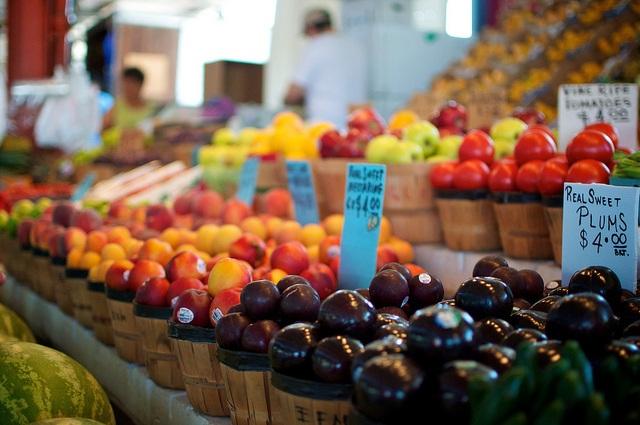
By Daniel Matthews
You know your local farmers market means fresh, organic produce. You know it means a personal touch, a return to a time when sterile supermarkets and huge parking lots weren’t the norm. But have you ever thought about what the farmers market means to the evolving economy? As a do-it-yourself model, a place where sustainable ways and new technology converge, the farmers market represents a commerce revolution.
Technology at the market
New technology and the farmers market? Seems like a contradiction. But when I go to the farmers market, one of the first things I notice is this: Every merchant accepts credit cards.
This, of course, is smart business. According to Square’s guide on how to accept credit card payments, people spend 12 to 18 percent more when they use a credit card instead of cash.
At the farmers market most recently, I bought a hand-crafted ceramic bowl for my mom from a local merchant called Keramica. The husband-and-wife owners, Keaton and Kara Skyles, were eager to chat about their business. I had limited cash, but because they had one of Square’s credit card readers, I ended up spending nearly $50 on a bowl “fresh from the kiln” (according to Keaton). They even had an EMV (Europay, Mastercard, Visa) device, something the supermarkets I normally go to aren’t on top of yet. But they should be. The new mandate from banks is if merchants don’t accept EMV, they’re liable for credit card fraud.
Keramica is one of millions in the growing DIY economy. In 2015, the number of self-employed workers rose by 370,000 in May alone. That marked a growth-spurt of one million entrepreneurs in just four months. Each vendor you see at the market is part of this movement.
The growth of the DIY movement parallels the growth of mobile payment and the smartphone market. With big players like Apple and Paypal in the mix, the mobile payment industry is expected to hit $189 billion by 2019, a growth of 154 percent from 2014. An entire chunk of purchases from small merchants such as Keramica wouldn’t be possible without the huge mobile payment industry.
Regardless of what you think of the credit card industry and banks that capitalize on debit card overdraft fees, a TSYS study in 2014 revealed that 78 percent of people prefer to pay with a card over other methods. This is good news for small, independent merchants, who benefit greatly from mobile credit card payments. This gives them the freedom to conduct business wherever they want.
Environmental sustainability at the market
As calls for sustainable, environmentally-friendly business practices increase, organic farmers are at the forefront of the movement. The Farmers Market Coalition has some key findings on how farmers markets promote sustainability:
- The local and regional produce you’ll find travels about 27 times less distance than “conventionally-sourced” produce
- 81 percent of farmers use farming practices that reduce waste and promote soil health, such as on-site composting and cover crops
- 3 out of 4 farmers follow practices “consistent with organic standards”
Organic standards include integrated pest management, which minimizes the use of pesticides and chemicals. A lack of chemicals allows predators, such as birds, to feed on harmful pests. Crop rotation comes into play here — it puts nutrients back in the soil instead of draining the land with monoculture.
Monoculture, the practice of cultivating a single crop on huge acreages of land, requires farmers to use more pesticides in order to control pests that prefer certain crops. Although an irrefutable link hasn’t been established, monoculture and pesticides may be the culprits of colony collapse disorder, which is the dissolution and death of entire bee colonies. Around 35 percent of U.S. crops rely on bees. Scientists have found traces of neonicotinoid insecticide in dead bees near agricultural fields, specifically corn fields where farmers use the insecticide.
Economic sustainability at the market
There are definite economic benefits associated with farmers markets.
Farmers markets return money to local economies, whereas a high percentage of profits from chain stores go elsewhere. Walmart, for one, has been implicated by Oxfam in the tax haven scandal that came to light following the Panama Papers leak. That means Walmart is not paying taxes on the profits it makes from grocery purchases.
Vendors can make all their income from farmers markets. In turn, they hire nearly five times more people than non-local vendors. Those workers hired by local farmers receive an education in sustainable farming. Down the line, that means more farm startups and more entrepreneurial investment.
Impoverished families can use food stamps at the market, meaning the $18.8 million of SNAP (food stamps) cash from 2014 went right back into local taxpayer pockets. Fresh organic produce means better health and lower obesity rates for poorer families. In turn, this places less of a burden on the health care system, lowering medical bills for poor families that can barely afford health insurance.
Producing results
Much like the gig economy, the farmers market do-it-yourself economy is leveraging new technology, such as mobile payment tech, to enable an increase in commerce. The USDA saw upwards of 8,000 farmers markets in 2014. That’s because it’s becoming easier to turn a good profit at the market.
The demand for organic food and DIY craftsmanship continues to rise. According to Base Creative researcher Woody Yip, on-demand consumption is one of 2016’s key trends, alongside “nature comfort." People are “turning to nature for comfort and discovering a newfound appreciation for processes once forgotten.”
It’s now easier than ever for organic farms to be on-demand. As consumers continue to move toward a preference for local, natural goods, farmers markets will be there to meet the demand.
Image credits: 1) Flickr/Gemma Billings 2) Flickr/John Tornow
Infographic courtesy of the Farmers Market Coalition
Daniel Matthews is a freelance writer focused on business.
TriplePundit has published articles from over 1000 contributors. If you'd like to be a guest author, please get in touch!














